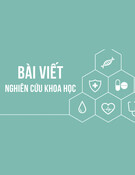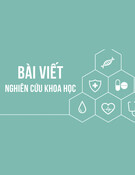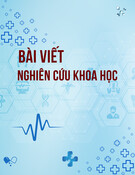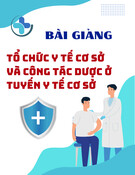
vietnam medical journal n03 - october - 2024
142
TÀI LIỆU THAM KHẢO
1. Baron TH, Wong Kee Song LM, Zielinski MD,
et al. A comprehensive approach to the
management of acute endoscopic perforations
(with videos) Gastrointest Endosc. 2012;76(4):
838–859. doi: 10.1016/j.gie.2012.04.476.
2. Chirica M, Champault A, Dray X, et al.
Esophageal perforations. J Visc Surg. 2010; 147(3):
e117–e128. doi: 10.1016/j.jviscsurg. 2010.08.003.
3. George Triadafilopoulos, J Thomas Lamont,
Shilpa Grover, Boerhaave syndrome: Effort
rupture of the esophagus, UpToDate, 2023.
4. Chirica M, Kelly M, Siboni S, et al. Esophageal
emergencies: WSES guidelines. World J Emerg
Surg 2019; 14
5. Radswiki, T., Weerakkody, Y. Boerhaave
syndrome. Reference article, Radiopaedia.org.
(accessed on 06 Nov 2022) https://doi.org/
10.53347/rID-12730
6. Turner AR, Turner SD. Boerhaave Syndrome. 2021
Dec 15. In: StatPearls [Internet]. Treasure Island (FL):
StatPearls Publishing; 2022 Jan–. PMID: 28613559.
7. Altorjay A, Kiss J, Voros A, et al. Nonoperative
management of esophageal perforations. Is it
justified? Ann Surg. 1997; 225(4): 415–421.
doi: 10.1097/00000658-199704000-00011
ẢNH HƯỞNG CỦA MỔ LẤY THAI ĐẾN LẦN MANG THAI SAU CỦA SẢN
PHỤ SINH LẦN 2 TẠI BỆNH VIỆN SẢN NHI CÀ MAU NĂM 2022-2023
Huỳnh Ngọc Linh1, Trương Minh Kiểng2, Nguyễn Việt Trí2
TÓM TẮT36
Đặt vấn đề: Mổ lấy thai liên quan đến sức khỏe
của mẹ và con trong ngắn hạn và dài hạn đặc biệt là
những lần mang thai sau. Do đó, xác định các nguy cơ
của mổ lấy thai đến lần mang thai sau là cần thiết.
Mục tiêu: Xác định tỷ lệ mổ lấy thai, các yếu tố như:
nhau tiền đạo, vở ối sớm, đái tháo đường, tăng huyết
áp thai kỳ; suy thai, cân nặng, chỉ số Apgar trẻ sơ sinh
giữa hai nhóm sản phụ sinh lần đầu bằng đường âm
đạo hoặc mổ lấy thai đến sinh lần 2 tại bệnh viện Sản
Nhi Cà Mau. Đối tượng và phương pháp: Nghiên
cứu đoàn hệ hồi cứu trên 2576 sản phụ sinh lần 2 tại
Bệnh viên Sản Nhi Cà Mau năm 2022-2023. Kết quả:
Nhóm sản phụ có tiền sử mổ lấy thai khi mang thai lần
2 có nguy cơ mổ lấy thai, nhau tiền đạo, vở ối sớm,
đái tháo đường, tăng huyết áp thai kỳ cao hơn so với
nhóm sản phụ đã sinh đường âm đạo lần 1 với RR lần
lượt là 5,68 KTC95%[4,60-7,02]; 1,21KTC95%[1,11-
1,31]; 1,45KTC95%[1,31-1,61]; 1,24KTC95%[1,08-
1,43]; 1,39 KTC95%[1,26-1,53]; 1,19KTC95% [1,03-
1,37]. Tuy nhiên đái tháo đường thai kỳ không có sự
khác biệt giữa 2 nhóm, p=0,69. Đối với trẻ sơ sinh ở
nhóm sản phụ đã mổ lấy thai có nguy cơ suy thai, nhẹ
cân hơn so với nhóm sinh đường âm đạo với RR lần
lượt là 1,51 KTC95%[1,38-1,63] và 1,24
KTC95%[1,08-1,42]. Kết luận: Sản phụ có tiền sử
mổ lấy thai có nguy cơ cho cả mẹ và con và hầu như
phải mổ lấy thai khi mang thai lần sau.
Từ khóa:
mổ lấy thai, sinh đường âm đạo, nhau
tiền đạo, vỡ ối sớm, suy thai.
SUMMARY
THE IMPACT OF CESAREAN SECTION ON
1Trường Cao đẳng Y tế Cà Mau
2Bệnh viện Sản Nhi Cà Mau
Chịu trách nhiệm chính: Huỳnh Ngọc Linh
Email: drlinhcm78@gmail.com
Ngày nhận bài: 26.7.2024
Ngày phản biện khoa học: 10.9.2024
Ngày duyệt bài: 8.10.2024
SUBSEQUENT PREGNANCIES IN SECOND-
TIME MOTHERS AT CA MAU OBSTETRICS AND
PEADIATRICS HOSPITAL YEAR 2022-2023
Introduction: Cesarean section is associated
with both short-term and long-term maternal and fetal
health, particularly in subsequent pregnancies.
Therefore, identifying the risks of Cesarean section on
subsequent pregnancies is essential. Objectives: To
determine the rate of Cesarean section, factors such
as placenta previa, premature rupture of amniotic
membranes, diabetes mellitus, gestational
hypertension; fetal distress, birth weight, and Apgar
score of newborns between two groups of primiparous
women who delivered vaginally or via Cesarean
section for their second delivery at Ca Mau Obstetrics
and Peadiatrics Hospital. Subjects and methods: A
retrospective cohort study of 2576 second-time
mothers at Ca Mau Obstetrics and Peadiatrics Hospital
from 2022-2023. Results: The group of mothers with
a history of Cesarean section during their second
pregnancy had a higher risk of Cesarean section,
placenta previa, premature rupture of amniotic
membranes, diabetes mellitus, and gestational
hypertension compared to the group of others who
had a vaginal delivery for their first delivery, with RR
values of 5.68 CI 95% [4.60-7.02]; 1.21 CI 95%[1.11-
1.31];1.45 CI95%[1.31-1.61]; 1.24 CI95%[1.08-
1.43]; 1.39 CI95%[1.26-1.53]; 1.19 CI95% [1.03-
1.37], respectively. However, there was no difference
in gestational diabetes mellitus between the two
groups, p=0.69. Regarding newborns, those born to
mothers who had a Cesarean section had a higher risk
of fetal distress and low birth weight compared to
those born vaginally, with RR values of 1.51 CI 95%
[1.38-1.63] and 1.24 CI 95% [1.08-1.42],
respectively. Conclusion: Mothers with a history of
Cesarean section are at risk for both themselves and
their children and are almost always required to have
a Cesarean section in subsequent pregnancies.
Keywords:
cesarean section, vaginal delivery,
placenta previa, premature rupture of amniotic
membranes, fetal distress.






























